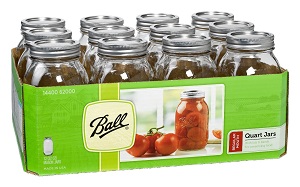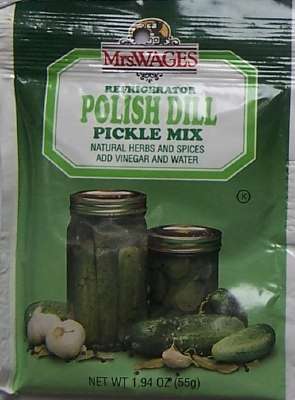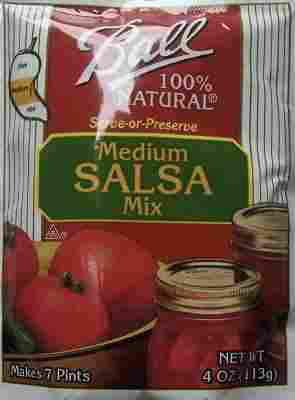
Looking for Why Do Canning Jars Break in My Canner? in 2025? Scroll down this page and follow the links. And if you bring home some fruit or vegetables and want to can, freeze, make jam, salsa or pickles, see this page for simple, reliable, illustrated canning, freezing or preserving directions. There are plenty of other related resources, click on the resources dropdown above. If you are having a hard time finding canning lids, I've used these, and they're a great price & ship in 2 days.
If you have questions or feedback, please let me know! There are affiliate links on this page. Read our disclosure policy to learn more.
Why Do Canning Jars Break in My Canner?
Canning Jar Breakage
It's bad enough when a filled canning jar breaks in the canner, making a mess and ruining a jar of good food. But when it happens more than once in a great while, that indicates a problem we can correct! What causes a canning jar to break is not quite the mystery that it appears to be.
Breakage can occur for many reasons. Here's my
Top 10 List of Why Canning Jars Break:
-
Using lower quality commercial food jars rather than jars manufactured for home canning
Miracle Whip and mayonnaise jars are the perfect size and the threads fit, but they break so easily in the canner they just aren't worth. Some spaghetti sauce jars (those whose tops fit a standard canning lid and ring) do seem to be more robust, and I don't recall ever having a "Classico" brand spaghetti sauce jar break. -
Using jars that have hairline cracks
Admittedly, hairline cracks can be difficult to see and few of us carefully inspect every jar for a thin crack before using them. -
The lids were overtightened
As the contents of the jar heat and expand, the air in the headspace is pushed out of a tiny gap between the lid and the jar, while the ring keeps the lid from lifting up too much and allowing water in! It works like a one-way valve, letting the expanding air out. This is necessary to create the vacuum, when you remove the jars from the canner, the contents cool, contract and suck the lids down. So, don't make the lids as tight as you can; just snug. Follow the lid manufacturer's directions. -
Putting hot food in cold jars
I leave my jars in the dishwasher on "heated dry", after running the "sanitize cycle". Some people fill their jars with the hottest water from their facet until the are ready to fill them. And of course, sterilizing them by submersing the empty jars in the canner or in a large pot of boiling water works well. If a jar is going to break, it would most likely do it then, while it is still empty! -
Putting cold food in cold jars and then immersing into the canner
Food and jars should be hot when placed in the canner. Sudden change in temperature create too wide a margin between temperature of filled jars and water in canner before processing. That leads to "thermal shock" in the glass jar. Pre-warm canning jars with very warm water, before you fill them. -
Food was packed too solidly or jars were overfilled.
Then as the jars heat in the canner, their contents expand and the jar breaks! Follow the recommendations for headspace, which are specific to each type of food. Some expand more than others, too! -
Putting jars directly on bottom of canner instead of on a rack.
This is easy to correct! Use a rack! I like the better quality stainless steel racks best, but in a pinch a wash cloth on the bottom of the canner (inside, of course) will work. -
Pressure canners have their own specific issues causing jar breakage:
- Canner became dry during the processing period. This is caused by either a steam leakage in your canner, which means you need a new part, or by using insufficient water for the processing period.
- Jars were placed directly on canner bottom. A canning rack should always be placed on the canner bottom. It is not necessary to place a rack between a layer of pint or half-pint jars. Stagger the jars by placing a top jar on two bottom jars.
- Pressure was reduced quickly after processing. Always let pressure drop of its own accord.
- Air was exhausted from canner at too high a temperature. Adjust heat so a steady gentle flow of steam emerges from the vent pipe.
- Pressure had fluctuated during the processing period. This can be caused by an unsteady heat source or steam leaking from the canner. -
Jars were placed in a cold, drafty place to cool.
Always allow the jars to cool jars on a towel or rack at room temperature, away from windows, vents and drafts. -
And finally, the jars themselves may be the cause of difficulty.
Jars eventually weaken with age and repeated use. Repeated heating and cooling cycles take a toll.
Crass Commercial Message?
If you are looking for canning jars, in almost any size and type; we have a reliable supplier below, and at the best prices you will find anywhere! Scroll down this page for photos, descriptions, prices and ordering information. Everything can be shipped by a variety of methods, including overnight, if you have a canning emergency! And I appreciate your business- buying the products here helps support the website!
 Canning jars delivered to your doorstep and guaranteed! Any size you need. Click on the links below
Canning jars delivered to your doorstep and guaranteed! Any size you need. Click on the links below
For more information, and NO obligation to buy, just click on the links in the boxes on the left!
-
Quart canning jars (excellent for apple sauce):
Regular quart (32 oz) jars -
Ball Regular Mason Canning Jars Case of 12
Wide mouth quart jars:
Ball Wide-Mouth Mason Canning Jar 1 Qt., Case of 12 -
Pint canning jars (great for salsa, pickles, apple butter):
Find this item (B00JI31388) on Amazon Regular pint (16 oz) jars :
Canning Jars, regular 1 Pint
Wide mouth pint (16 oz) jars:
Ball Wide Mouth Can-or-Freeze Canning Jar 1 Pt., Case of 12
Wide mouth Canning Jars with a Handle - make good mugs:
Libbey Country Jar 16-Ounce Mason Jar Glasses, Set of 12 -
8 oz canning jars: perfect for jams and jellies, chutneys:

Standard 8 ounce jars:
Ball Deluxe Quilted Jelly Canning Jar 8 Oz., Case of 12
Decorative oval 8 ounce jars:
Bormioli Rocco Quattro Stagioni 8 1/2 Ounce Canning Jar, Set of 12 -
4
 oz jars: for wedding gifts, tokens, and very small items:
oz jars: for wedding gifts, tokens, and very small items:
Tall 4 ounce canning jars:
ALLTRISTA (BALL CANNING) 1440080400 JELLY JARS 4 OZ BOX OF 12
Short 4 ounce canning jars:
Jarden 4-Ounce Mason Canning Jars, 12-Pack
See here for related tools, equipment, supplies on Amazon
See here for related tools, equipment, supplies on Amazon
See here for related tools, equipment, supplies on Amazon
See here for related tools, equipment, supplies on Amazon
See here for related tools, equipment, supplies on Amazon
See here for related tools, equipment, supplies on Amazon
Canning Hand Tools
Buy quality canning helpers. These provide the home canner with the essential tools needed for safe and efficient home canning.
Anything you could need is here, at discount prices
Canning Rack
Features:

See here for related tools, equipment, supplies on Amazon
- Stainless steel, this rack won't rust
- Accommodates non-standard jar sizes, smaller jars can't fall through
- Holds 14 jelly jars, 14 half-pint, 9 pint or 7 quart jars at one time
- Small jelly jars won't fall through
- 12-1/4 in diameter and 3-3/4 deep (not including handles). Made in USA.
- Manufacturer: Kitchen Krafts
This Water Bath Canner Rack fits most boiling waterbath canners.
Blake's rating : Excellent replacement rack (sooner or later your rack will fall apart from the boiling water (and no, this one is not made of silicone...)
More Canning Supplies
|
|
|
See here for related tools, equipment, supplies on Amazon
Decorative Canning Lids:
|
Lids and Rings (jars are above)click here for jarsNeed lids, rings and replacement jars? Or pectin to make jam, spaghetti sauce or salsa mix or pickle mixes? Get them all here, and usually at lower prices than your local store! Click on the images at left for current prices and/or ordering! \ |
| See here for related tools, equipment, supplies on Amazon |
Cleaning supplies to remove rust from rings and jarsA visitor wrote in to tell how she uses Copper Glo (order at ledt) to remove rust from rings and jars:
Comments from a visitor on September 15, 2010:
"You mention not using jars that have rust on them. One way to remove rust from jars is with Copper Glo. I get Copper Glo at our local Giant Eagle. I had a jar with rust on it and was getting ready to pitch it when my mom told me about Copper Glo. I was afraid to use it at first because I was afraid it would scratch the jar, but decided it was worth a try. Amazingly, the rust came off and the jar wasn't scratched!"
|
|
|
Rubber seals for the older zinc caps - Know first that home canning experts do not recommend that you use the rubber ring system. The modern flat lid and metal ring system (above) is superior in reliability and safety. If you insist in using the rubber ring system, do not use old rubber rings: they have aged and will probably not seal effectively, especially on an older jar. You can get new rubber canning rings quite inexpensively here.: |
Books |
|
Canning booksCanning & Preserving for Dummiesby Karen Ward click here for more information, reviews, prices for Canning and Preserving For Dummies |
|
The All New Ball Book Of Canning And Preserving: Over 350 of the Best Canned, Jammed, Pickled, and Preserved Recipes PaperbackThis is THE book on canning! My grandmother used this book when I was a child. It tells you in simple instructions how to can almost anything; complete with recipes for jam, jellies, pickles, sauces, canning vegetables, meats, etc. If it can be canned, this book likely tells you how! Click on the link below for more information and / or to buy (no obligation to buy). |
|
|
See this page for pressure canners . Also see Canners for glass top stoves , if you have a glass or ceramic stove For other supplies:
You can read a discussion about why foods should be processed in a canner on this page" " Why do I need a canner? " Pectin, Pickle Mixes and Sauce/Salsa Mixes |
|
Making Jam? Need Pectin, but the local store is out?Is your jam too runny? Pectin enables you to turn out perfectly set jam every time. Made from natural apples, there are also low-sugar pectins that allow you to reduce the sugar you add by almost half! |
|
Pickling Mixes and Pickling Supplies |
|
|
|
PicklesWhether you want dills or sweet pickles; canning them or straight into the refrigerator; there is a mix for every taste and need here! Get them all here, delivered direct to your home, at the best prices on the internet! Get everything you need to make pickles: mixes, salt, brine, etc. here! |
Sauce and Salsa MixesGet ready season mixes for tomato sauces and salsas here. They make it simple to get it right every time! (Shown is Ball brand - actual is Mrs. Wages brand) |
|
Complete Guide to Home Canning and Preserving
by United States Dept. of Agriculture
This book is a compendium of the USDA's research and tested recipes. It explains the scientific principles behind home canning , canning equipment, and the proper use of jars and lids. It is written by government folks, so it is pretty dry, but it is accurate. It includes recipes for fruit; tomatoes; vegetables; poultry, red meat, and seafood; fermented foods and vegetables; and jams and jellies and contains updates based on research in the last 20 years for canning safer and better quality food at home.
Looking for canning equipment and supplies?
Water bath canner with a jar rack
Pressure canners for gas, electric and induction stoves: Presto 23Qt or T-fal 22Qt
Canning scoop (this one is PERFECT)
Ball Blue book (most recent version)
Jars: 8oz canning jars for jams
Find Other types of farms:
Farm markets and roadside stands
Road trips and camping resources
Local Honey, apiaries, beekeepers
Consumer fraud and scams information
Home canning supplies at the best prices on the internet!
Maple Syrup Farms, sugarworks, maple syrup festivals
Environmental information and resources
Farms For Your Event for birthday parties, weddings, receptions, business meetings, retreats, etc.
Festivals - local fruit and vegetable festivals
Get the
most recent version of
the Ball Blue Book
With this Presto 23 quart pressure canner and pressure cooker, you can "can" everything, fruits, vegetables, jams, jellies, salsa, applesauce, pickles, even meats, soups, stews. Model 01781

You can make jams, jellies, can fruit, applesauce, salsa and pickles with water bath canners, like this Granite Ware 12-Piece Canner Kit, Jar Rack, Blancher, Colander and 5 piece Canning Tool Set




